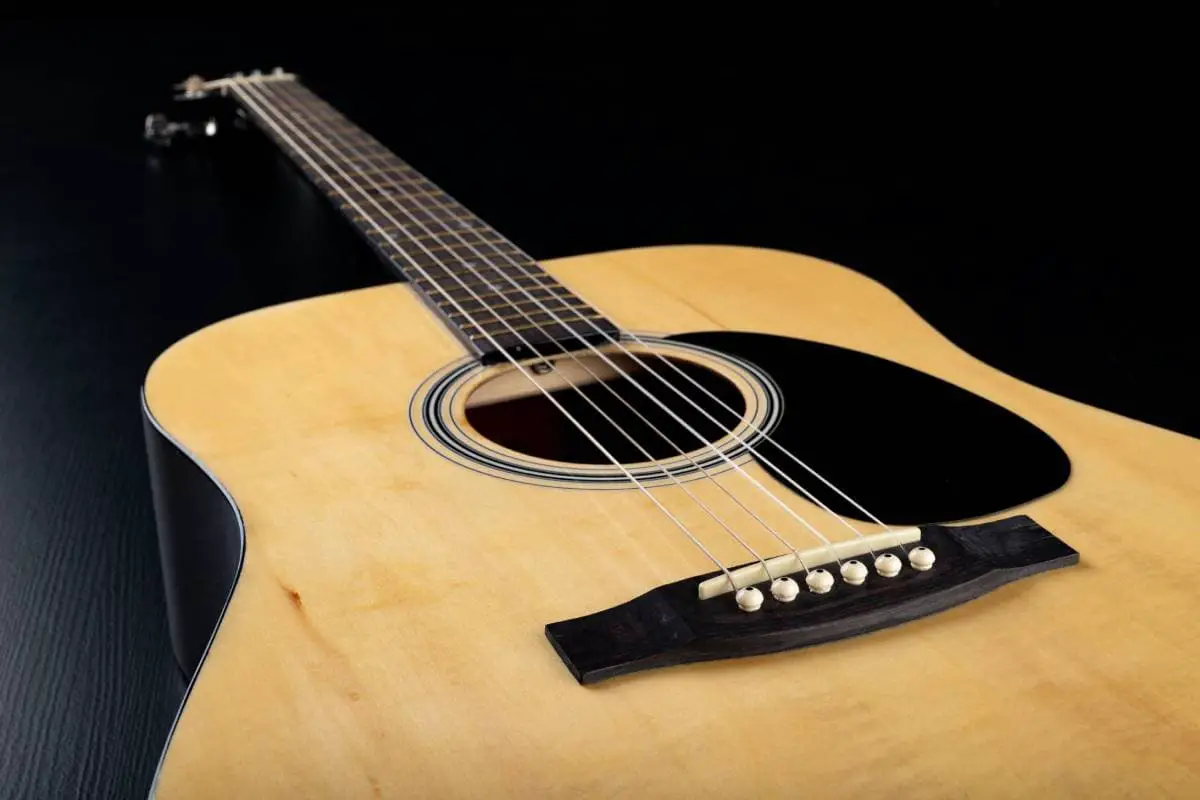Your guitar’s action affects the way you play it, how it sounds, and more. In fact, when the action is too high, it can break numerous parts of the guitar. Furthermore, it prevents you from playing the instrument without facing difficult resistance. The good news is that it’s quite easy to spot when your guitar’s action is more than it should be.
Subtle signs your guitar’s action is too high include buzzing frets, difficulty compressing the strings, twangy noises, and trouble bending the strings. You might also notice that the neck is bent or the tuning pegs are loose. This happens because the action tugs on the strings, pegs, and bridge.
Throughout this article, we’ll break down the top reasons your guitar’s action gets too high, how you can spot them, and what you can do to fix each issue.
👇😀👇NOTE👇😀👇
If you want to find out what my recommended guitar gear is, then here is what I recommend on Amazon:
- Fender Cutaway Acoustic-Electric Guitar Bundle (MY FAVORITE GUITAR)
- Snark SN-8 Super Tight All Instrument Tuner (Easiest Tuner I’ve Used😏)
- 6 String Acoustic Guitar Capo (Best CAPO for quick changes)
- Dunlop Max Grip 1.0mm Nylon Picks (Thick Guitar Pick So You Don’t Lose Grip!)
- Universal Guitar Stand (Cheap & Minimalist Guitar Stand I Recommend)
- Levy’s 2″ Wide Quick Adjust Guitar Strap (Best Guitar Strap For Any Level)
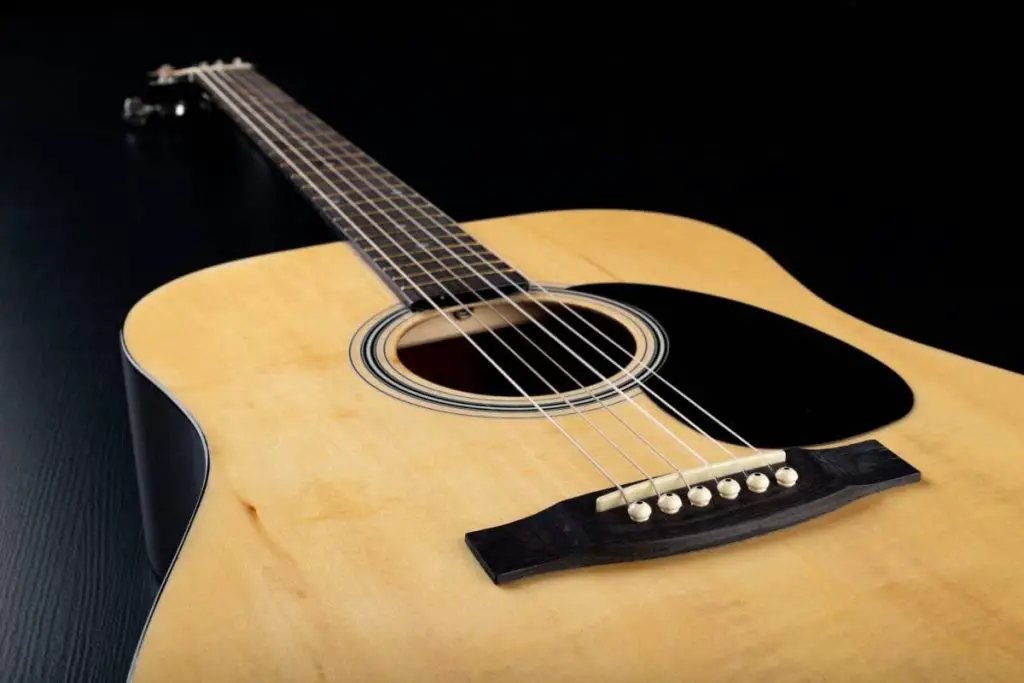
Frets Buzz When You Strum the Guitar
One of the most common symptoms of high action on a guitar is buzzing strings and frets. When the action is too high, it compresses some of the strings near the top of the neck. You might have no problem strumming and picking near the neck’s base, but the lower chords and strings will buzz like never before.
Here’s how to know if your frets are buzzing from high action issues:
- Bar the first fret, then strum the guitar. You shouldn’t hear any buzzing, muting, or anything other than the normal sound of the strings. You should also be able to bar the fret without facing too much resistance. When the action is perfect, none of these issues are present from start to finish.
- Look under the strings near the barred fret to see if any of them are touching the frets. The only frets that should touch the strings are the ones that you’re touching. If the frets are touching the strings on one or more frets in front of the chord, then the action needs to be adjusted before you play the guitar.
- Make sure the bridge is slightly slanted. The bridge needs to be higher at the lowest E string and lower at the highest E string. This slant helps the action by promoting optimal tension on each of the strings. If the bridge is flat or wobbly, it means you need to replace the bridge, not adjust the truss rod.
- Loosen the strings, tighten them, and test the frets again. Sometimes, all you have to do is stretch the strings a little bit. New strings need to be broken in, which means you don’t have to worry about changing the action too much. If this doesn’t work, use an allen wrench to loosen the truss rod ¼ of an inch.
It’s Difficult to Compress the Higher Frets
When your guitar’s action is too high, everything gets harder to play. The Vault explains the strings are further from the fretboard, which means you have to push them harder to make them touch. Furthermore, a high action on a guitar tightens the strings. You’ll be facing more resistance on every string, especially the ones highest above the fretboard.
So, what can you do if the high frets are too hard to play?
- Loosen the adjustment nut to alter the truss rod. This nut is adjusted with an Allen wrench. Try the Meideal Guitar Truss Rod Adjustment Set. It comes with every possible Allen key you need to change your guitar’s truss rod. Remember that a small ¼-inch turn is enough to make a significant difference.
- Get lighter strings and ensure they don’t pull the neck too hard. Older guitars have weaker necks, which means you’ll need to use lightweight strings. These strings put less pressure on the neck, preserving the guitar’s structural integrity for many years to come. Lighter strings are also better for fingerpicking, which is an added bonus!
- Break in the strings by playing with them regularly. New strings take a couple of hours of strumming and picking before they’re loose enough to stay in tune. The intonation changes a few times while breaking in newer strings. Once the strings are ready to go, they won’t put as much stress on the action.
Each String Sounds Tinny
Tin sounds come from guitar strings when they’re stretched too far. This sound is a mix of buzzing frets and narrowing (and likely breaking) strings. When the action is too high, the strings are under constant pressure. While they’re supposed to be secure, the strings shouldn’t be pulled in both directions as they are with a higher action.
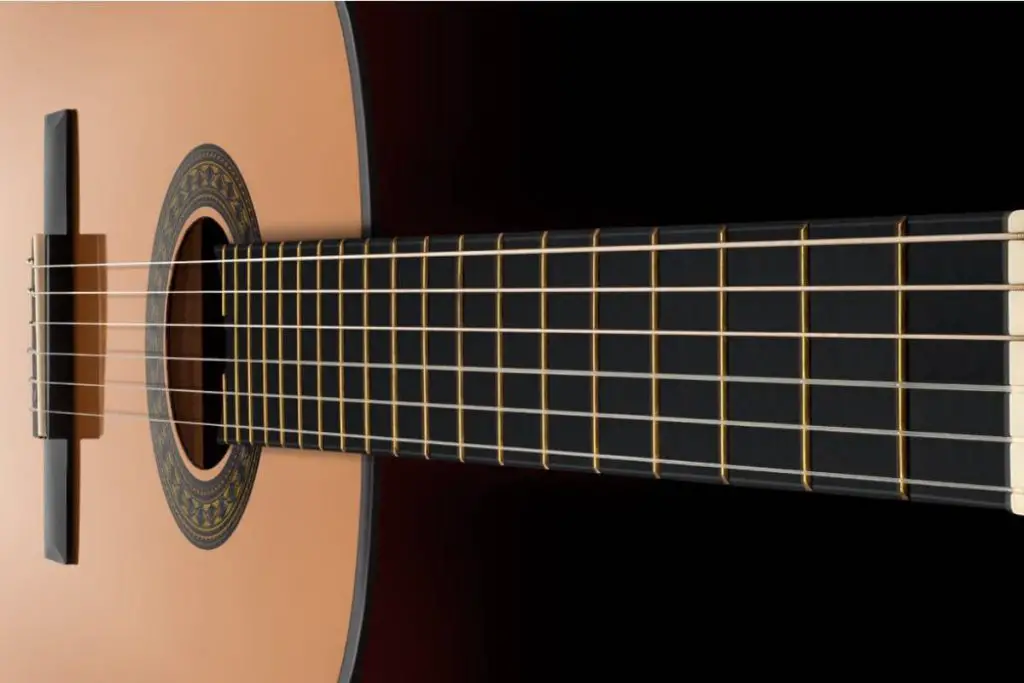
If you’re not sure if the action is too high, try a testing kit. The Music Nomad Precision Truss Rod Tool tells you how much you need to adjust the action. Place the thin tool against the fretboard to measure the string’s distance. You can use an Allen key to make minor adjustments while leveling the strings with your new gauge.
The Strings Won’t Bend With Your Fingers
If you bend the strings by pushing them up and down, you’ll hear a unique pitch change. This move is common in bluegrass and rock music, but it’s made its way into almost every music genre. However, having a high action from the tight truss rod can make it almost impossible to bend the strings.
Fortunately, there are a few ways to identify if the action is the cause of this common problem. Let’s explore them below.
- If the bridge moves when you bend the strings, the action might be too high. A higher action on your guitar will put a lot of stress on several parts, including the bridge. When the strings push on the bridge too hard, they can cause intends, shift the bridge, or crack the edges.
- The action is likely the cause if the strings push your fingers off of them when you try to bend them. Compress one of the strings, strum it with the other hand, and try to push the string up or down while it’s on the fretboard. If you can’t move the string, the action is pulling the strings much tighter than it should.
- Your guitar’s action is far too high if the strings buzz every time you bend them. A slight bend shouldn’t cause any buzzing. If it does, there’s a good chance the strings are touching a fret further up the board. This sound is caused by the strings being too close to the fretboard, especially on the space closest to the headstock.
Bent or Loose Tuning Pegs
Your guitar’s tuning pegs hold the strings, letting you adjust them to change the tuning. The bottom of the pegs is mounted with multiple screws drilled into the wood. If the action is too high on the guitar, it’ll put too much pressure on the tuning pegs.
The constant pressure from the guitar’s action is usually distributed between the bridge, neck, and tuning pegs. However, a higher action than normal will put far too much pressure on the individual parts. The uneven distribution can wreak havoc on the tuning pegs, which can cause various issues.
For example, the concerns could take place:
- The tuning peg’s screws could strip the wood. The action’s pressure moves the pegs and compresses the wood around them, preventing them from staying sealed. You’ll have to constantly tighten the tuning peg’s screws, which makes the guitar go out of tune. Furthermore, you might have to replace the screws if it continues.
- The pegs might bend the strings, making it almost impossible to tune them. Your guitar’s tuning pegs need to be snug every time you strum the strings. If the action wiggles the pegs, you’ll never be able to maintain the intonation or tuning. The strings will be stretched and compressed repeatedly.
- The pegs could bend and break, which means you’ll need to get new ones. Tuning pegs are typically inexpensive, but nobody wants to replace a guitar part if they don’t have to. It’s also frustrating because it can be difficult to find tuning pegs that match the existing set on your guitar.
The Guitar’s Neck is Bent
A bent guitar neck is a common sign that the action is too high. When the action pulls the tuning pegs, it bends the guitar’s neck. This issue is often called a bowed neck. It looks like a banana, pulling the headstock closer to the base of the neck. Not only does it cause unwanted pressure, but it also makes it very hard to strum, pluck, and play chords.
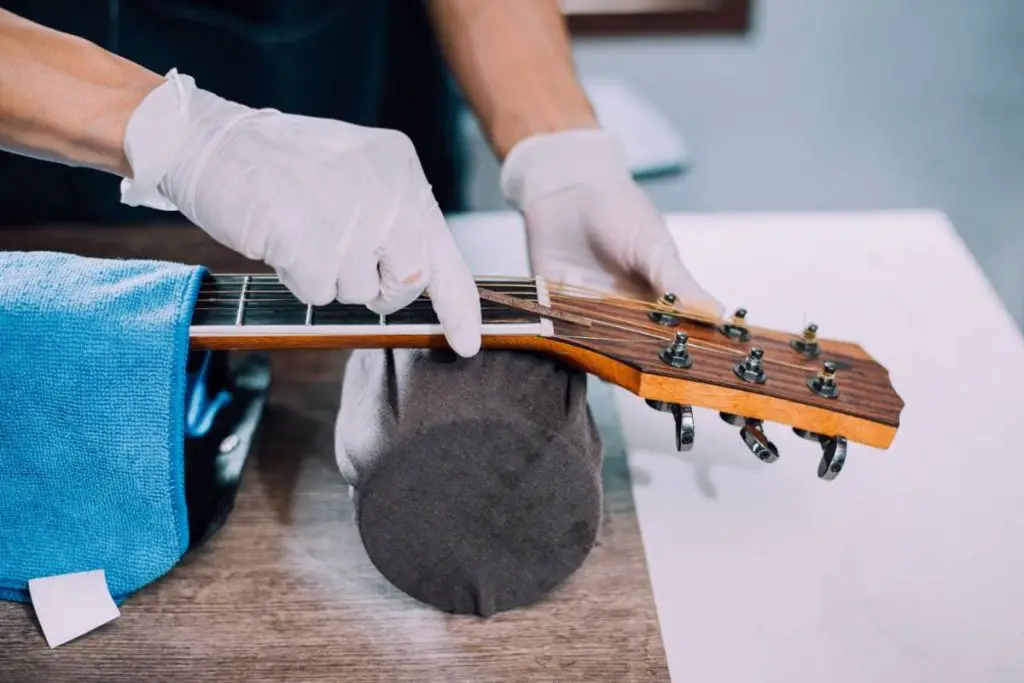
Here’s how to know if your guitar has a bowed neck:
- Place a yardstick on the neck and make sure it’s flat against the fretboard. Your guitar’s neck should be as flat as possible. A slight bend is okay since many guitars can’t be completely flat without buzzing. Keep in mind that a low action is just as bad as a higher action. If it’s too far either way, the strings will buzz.
- Look at the guitar from the side to view under the strings. You should be able to see a bit of light under each string on every fret. None of the strings should touch the frets, or they’re far too close to the fretboard. This lineup will cause unwanted buzzing sounds, leading to early wear and tear.
- Loosen the truss rod until the neck isn’t bowed in either direction. If it’s too loose, the truss rod could bow outward; if it’s too tight, the truss rod could bow inward. The previously mentioned banana shape is caused by an extremely high action. Make sure you only turn the truss rod about ¼ of an inch since a little goes a long way.
- Consider replacing the strings if they’re stretched too far. A higher action on a guitar can tighten the strings too much. They’ll be thinner than they should be, which means they’re prone to snapping. It’s much better to replace the strings before they snap because the sudden loss of pressure can damage the fretboard.
If you’re interested in learning more about why a higher action bends the guitar’s neck, watch this YouTube video:
Some Strings Touch the Fretboard
None of the guitar strings should touch the fretboard if you don’t compress them. Strum the guitar without touching the fretboard and listen for a buzzing sound. If the strings buzz, you’re likely encountering a similar issue to the aforementioned string buzzing issue. This happens because the strings aren’t high enough from the frets.
While a higher action often causes this problem, it’s important to know that two other things can cause it, too. Here they are:
- The nut and the bridge are too low on the guitar. When the nut and the bridge are lower than they should be, they bring the strings much closer to the fretboard. Your strings might touch the fretboard, but changing the action won’t do anything about it. Make sure the strings are high enough over the neck.
- The strings are too small for the guitar. If your guitar strings are too short, they’ll stretch and touch the fretboard. While most manufacturers make the strings long enough for any guitar, it’s important to check their length beforehand. The strings should be a few inches longer than the distance between the bridge and the tuning pegs.
According to Guitar Gear Finder, the low E string should be about 2.8mm from the fretboard, whereas the high E string should be around 2mm from the fretboard. If they’re too close or too far, the action needs to be adjusted, and the nut and the bridge should be monitored. If the problems continue, change the strings and check their height with a ruler.
The Adjustment Nut is Too Tight
The truss rod determines the action. When the action is too high, the adjustment nut is too tight. Since the adjustment wrong controls the truss rod, their relationship is crucial. Check the adjustment nut to ensure the wood around it isn’t stripped. It’s also a good idea to look for damage on the adjustment nut since it can get difficult to alter the truss rod.
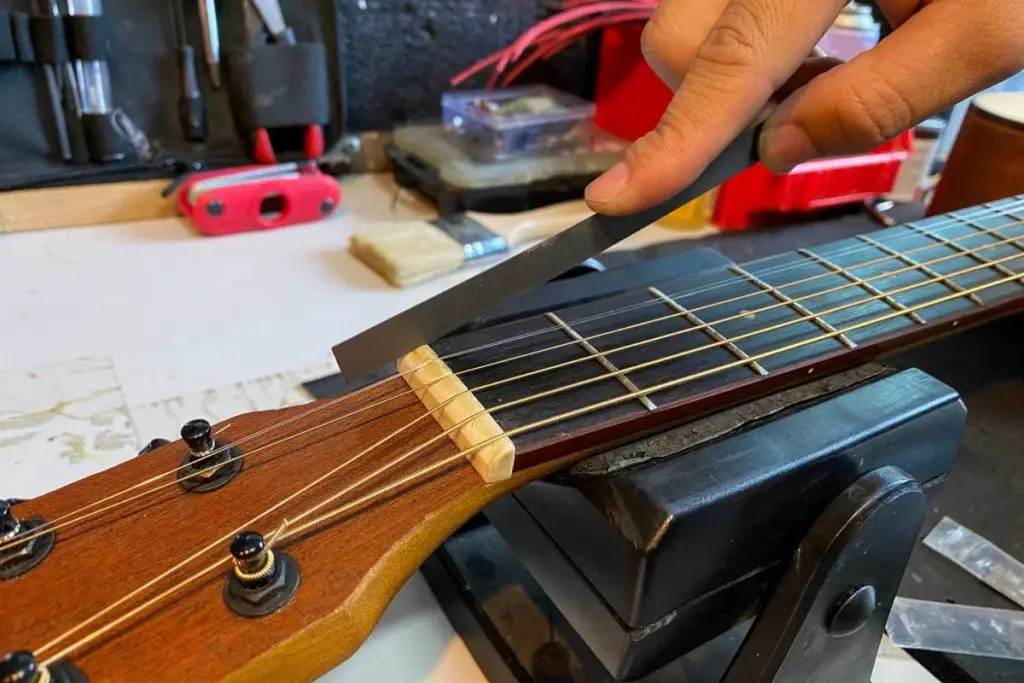
A Lack of Intonation
A guitar’s intonation refers to the way it sounds when you play various chords and strings. If the guitar sounds different when you play the same chord twice, something’s wrong with the action, strings, nut, bridge, neck, or tuning pegs. All of these components are affected by the guitar’s truss rod.
Follow this process of elimination to know if the action is causing intonation problems:
- Check if the tuning pegs are loose. Loose tuning pegs are caused by wear and tear, but a higher action can expedite the process. When the action is too high, there’s a good chance the tuning pegs will eventually take the full force. They shouldn’t wiggle or shift at all when they’re in good condition.
- Tighten and tune the strings. Your guitar strings should stay in tune for several hours of playing. New strings take a little while to break in, but you shouldn’t have to tune them every time you pick up the instrument. However, you might have to tune them more often when it’s time to get a new set of strings.
- Look if the neck is bowed or flat. A flat neck is preferred, though a slight curve isn’t a big deal. Never let the neck get too bowed inward or outward. If it looks this way, it’ll ruin the intonation. You can’t play a bowed guitar and expect the same sounds and intonation as a tuned guitar with a flat neck.
- Figure out if you can move the adjustment nut. If the adjustment nut is locked, the truss rod might be damaged. Take the guitar to a local music shop to get it repaired and find out if the truss rod is worth salvaging.
The Strings Snap Too Often
When the action is too high, the constant tension on the strings causes them to snap. You might notice that you’re always replacing the strings. Most guitar strings last for several months, so you shouldn’t have to get new ones too often. In fact, you’ll often notice it’s time to replace the strings because they’re worn, corroded, or don’t produce the same pitch.
It’s important to keep in mind that there are a few other reasons your guitar strings snap. Blaming the action could cause you to make unnecessary adjustments that will alter the neck, bridge, and more.

Here’s a quick list of reasons your strings snap:
- Weak strings
- Tight tuning
- Excessively hard strumming
- Low-budget strings
- Natural wear and tear from overplaying
- High or low action stretches the strings too much.
Final Thoughts
High action on a guitar can ruin the way you play. Not only does it make everything more difficult, but it can also cause you to break your guitar’s neck, fretboard, strings, bridge, and more. Adjusting the action is a crucial part of owning and maintaining any stringed instrument.
👇😀👇NOTE👇😀👇
If you want to find out what my recommended guitar gear is, then here is what I recommend on Amazon:
- Fender Cutaway Acoustic-Electric Guitar Bundle (MY FAVORITE GUITAR)
- Snark SN-8 Super Tight All Instrument Tuner (Easiest Tuner I’ve Used😏)
- 6 String Acoustic Guitar Capo (Best CAPO for quick changes)
- Dunlop Max Grip 1.0mm Nylon Picks (Thick Guitar Pick So You Don’t Lose Grip!)
- Universal Guitar Stand (Cheap & Minimalist Guitar Stand I Recommend)
- Levy’s 2″ Wide Quick Adjust Guitar Strap (Best Guitar Strap For Any Level)
Related Posts:
- 10 Best Things To Do With an Older Acoustic Guitar
- 11 Tips for Playing Guitar and Piano Together
- 4 Ways To Keep a Guitar From Getting Dusty
- 5 Major Differences Between a Guitar and a Violin
- 6 Reasons Why Your Acoustic Guitar Strings Buzz
- Guitar Tuner Not Working? Common Causes and Fixes
- Guitar Action Guide: How to Measure and Adjust Action

